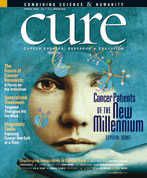Publication
Article
CURE
v4n4 - Fertility Choices
Author(s):
Cancer treatment can adversely affect cancer patients’ fertility days, months and even years after treatment. Young cancer survivors have options available to them for preserving fertility, and with new research, patients are offered more choices before and after therapy.
Prostate and testicular cancer therapies can affect sperm production, resulting in low sperm count or infertility. Chemotherapy for lymphoma and leukemia can also damage reproductive organs.
For men wanting to preserve fertility, freezing sperm at a sperm bank or fertility center has been a successful technique for decades. If sperm count is low, a process called intracytoplasmic sperm injection is available, where only one sperm is needed to fertilize an egg. Another technique, testicular sperm aspiration, in which sperm is taken directly from the testicle or from resected testicular tissue, is being studied as another possibility when sperm count is low.
For women, certain chemotherapies and hormone treatments, as well as radiation to the pelvic area, can damage the ovaries and other reproductive organs and induce early menopause. Because women are born with a limited number of eggs, or oocytes, damaging them during cancer treatment can leave a woman infertile.
If radiation is administered to the pelvis, the ovaries can be surgically moved from the field of radiation, called oophoropexy, which cuts the risk of damage by 50 percent. Treatments that temporarily shut down ovarian function during chemotherapy are also being investigated as a means to prevent damage to the eggs. A multicenter trial to investigate if Zoladex® (goserelin) protects ovarian function in breast cancer patients is currently ongoing.
With in vitro fertilization (IVF), an egg is fertilized and frozen, or cryopreserved, until it is later thawed and inserted into the uterus. Since IVF must be done before treatment, women needing immediate treatment may not be able to wait the several weeks required to retrieve viable eggs. Hormonal treatments are given to promote egg development, but there are natural methods available that do not involve hormone injections. IVF with frozen embryos has a high success rate, and women can use donor sperm.
While freezing unfertilized eggs is possible, the success rate is much lower than embryo freezing. Once thawed, the egg is fertilized by intracytoplasmic sperm injection and inserted into the uterus. Although freezing unfertilized eggs is considered experimental, better freezing and fertilization techniques are improving success rates and more clinics are offering the treatment. Researchers are also exploring ways to freeze testicular and ovarian tissue to be transplanted back into the patient after therapy.
Young cancer survivors also turn to adoption or surrogacy, which can include using a donor’s egg with sperm from the patient’s partner or the patient’s own fertilized egg if the uterus is damaged because of radiation.
Because many of these new fertility procedures are experimental, most are not covered by insurance and the cost can be as high as $20,000. Even traditional IVF can cost around $10,000. Depending on your insurance plan, diagnosis of infertility and some treatments may be covered. Financial assistance is available through organizations such as Fertile Hope, which offers fertility information and resources for cancer survivors






